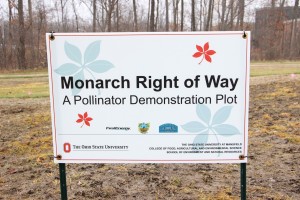
MANSFIELD, Ohio — Orchards, vegetable growers and many other producers need pollinators to help their plants thrive. But in recent years, the U.S. has experienced a significant drop in pollinators from honeybees to Monarch butterflies.
“Right now we are seeing a decline of pollinators, including monarch butterflies and honey bees,” said Marne Titchenell, wildlife program specialist at Ohio State University. “Ohio has seen a 50 percent decline in Monarch population.”

In an effort to combat a steady decrease in pollinator populations, Ohio State University’s Mansfield campus is implementing a Monarch Right of Way, pollinator demonstration plot, right in the heart of campus.
“We want these plots to attract the community programs and arborists,” said Denise Ellsworth, program director, Honey Bee and Native Pollinator Education at Ohio State University. “We want people to come and learn as we learn.”
Related: How to build a bee box for native pollinators
The project is a collaborative effort between Ohio State Extension, First Energy, Ohio Prairie Nursery, Arnold’s Landscaping and Davey Tree. The plot, a quarter of an acre of land, sits under First Energy utility lines that cut across campus.
Planning the plot
Planning and conversations about what could be done with the space have been going on for a couple of years. The idea for the plot itself was introduced by First Energy, explained Titchenell. “First Energy was looking for different ideas to offer landowners who have electrical right of ways on their property,” she said.
The ground below an electrical right of way has minimal options for what can be planted there. The lower growing plants of the pollinator plot will only reach a maximum of six feet, making them a good option for the plot.
Using the right of ways on the Ohio State Mansfield campus tied in well with the campus getting ready to launch a new environmental program next fall explained Brian White, project manager at Ohio State Mansfield. “It will be part of an Ecolab that promotes environmental and ecological research and outreach. It’s the first partnership under the Ecolab to do a research plot.”

Preparing the plot
In order to get the area ready for planting, herbicides were applied to the ground to kill grass and weeds in different patches where the plants would be growing. The team had planned to begin frost seeding in November, but Ohio’s unnaturally warm and wet weather late in the season set the planting back.
In early December, volunteers seeded the plots with a variety of seed mixes donated by Ohio Prairie Nursery. Seed mixes included a Rain Garden mix, Eastern Great Lakes Native Pollinator Mix and Fall Pollinator Fuel mix. Titchenell said, they did not alter any of the mixes, so if anyone wanted to replicate what they see in the garden, they could look up the mix and get the exact same seeding.
Frost seeding is a common way to seed native flowers and grasses, explained Titchenell. After clearing the herbicide treated ground of any remaining grass and weeds, seeds were spread out over the plots using drop seeders. “Then we cross our fingers and walk away until spring,” said Titchenell. As the ground naturally freezes and thaws over the winter months, the seeds will work their way into the ground.

How it will look
What looks like a plot of dead, brown oblong shapes now, will soon be filled with blooming native flowers and colorful grasses and shrubs. Flowers like Echinacea, purple clover, Asters, goldenrod, purple coneflower and more will bloom at different times throughout the year.
“We won’t see the full potential of the plot for a couple years,” she explained, some of the native flowering and nectaring plants take time to establish a root system. “But we should see some cool season grasses coming up in the spring.”
Titchenell and her team envision the area to be a place where both students and the community can come to learn more about the pollinators in our area. Signs will be stationed at each plot to describe what is growing there and what kinds of pollinators it attracts.
“It’s going to be a really beautiful plot and homeowners can take an eight of these plots and create something at their own homes,” said Titchenell. “Once (a plot) is established it is easy to maintain.”











Good to see some care taken for the pollinators.
“Frost” seeding–that’s a new one on me. Sure hope it works! At my place on the Ashland/Richland County line, gosh, the chickadees, nuthatches, and chipmunks would consider all that seed laying on the ground a tasty Holiday treat!
Plus, I sure do hope some of the “backyard” or weekend farmers get wise and start getting serious about calibrating their equipment to apply pesticides, herbicides, and the like that they use. I’ve seen too many of these cowboys over-drench their places with these potions under the idea “if an application of “x” on the label is recommended, why then “2X” is even better. NOT!
Rarely have I seen true farmers be so cavalier.
Just in case you want to know more about frost seeding, we’ve had some information in our “All About Grazing” column from time to time. Here are some links: http://www.farmanddairy.com/news/give-frost-seeding-try-right-now-improve-pastures/181513.html, http://www.farmanddairy.com/columns/frost-seeding-for-pasture-improvement/34326.html and http://www.farmanddairy.com/columns/heres-how-to-frost-seed-your-pasture/8118.html